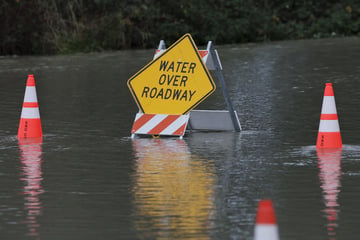Hurricane Milton: Death toll climbs to 16 as Florida begins challenging clean-up
Siesta Key, Florida - The death toll from Hurricane Milton rose to at least 16 on Friday, officials in Florida said, as residents began the painful process of piecing their lives and homes back together.

Nearly 2.5 million households and businesses were still without power, and some areas in the path cut through the Sunshine State by the monster storm from the Gulf of Mexico to the Atlantic Ocean remained flooded.
Milton crashed into the Gulf Coast late Wednesday as a Category 3 storm, smashing communities still reeling from Hurricane Helene two weeks ago, which killed 237 people across the southeast, including in Florida.
On Siesta Key, a beautiful barrier island near Sarasota where the storm made landfall, Milton left a desolate landscape.
Some streets were still flooded on Friday. Fallen trees and debris – sofas, beds, chairs, and appliances, much of it left behind by Helene – were strewn haphazardly on roadsides.
Resident Mark Horner, who moved there six years ago, said while his house was largely spared, the island "got hit really hard," and people were reassessing the future.
But the 67-year-old sounded a note of optimism, telling AFP: "Our paradise will come back. It's just a little shocking to absorb it."
Tornadoes, not floodwaters, were behind many of the storm's deaths.
In Fort Pierce, on Florida's Atlantic coast, four people died in a tornado spawned by Milton.
Florida spared "worst-case scenario" – but damage is still immense

"They did find some people just outside dead, in a tree," 70-year-old resident Susan Stepp told AFP. "I wish they would have evacuated."
At least six people were killed in St. Lucie County, four in Volusia County, two in Pinellas County, and one each in Hillsborough, Polk, Orange, and Citrus counties, officials said.
The storm downed power lines, shredded the roof of the Tampa baseball stadium, and inundated homes, but Florida avoided the catastrophic devastation that officials had feared.
"The storm was significant, but thankfully, this was not the worst-case scenario," Governor Ron DeSantis told reporters.
The National Weather Service issued a record 126 tornado warnings across the state Wednesday, wrote hurricane expert Michael Lowry.
"It is not easy to think you have everything and suddenly you have nothing," said Lidier Rodriguez, whose Tampa Bay apartment was flooded.
Search operations were ongoing Friday, and the Coast Guard reported the spectacular rescue of a boat captain who rode out the storm clinging to a cooler in the Gulf of Mexico.
"This man survived in a nightmare scenario," Dana Grady of the Coast Guard's St. Petersburg sector said in a statement.
Florida residents reassess the future after Helene and Milton

Experts said Friday that human-induced climate change made Hurricane Milton wetter and windier.
"Heavy one-day rainfall events such as the one associated with Milton are 20-30% more intense and about twice as likely in today's climate," the World Weather Attribution group of climate scientists said in a report.
The effect boosted Milton's wind strength by about 10%, making what would have been a Category 2 storm a more destructive Category 3, on a five-point scale, the report said.
Milton left some weary Floridians fed up and others digging in for the long haul.
In Orlando, on the east coast, 58-year-old Joe Meyer was loading his car after five days in a hotel to return home to Madeira Beach, south of Tampa.
Helene had hit his house "like a bomb went off," and he had to swim to a neighbor's house. Milton left less water but more wind damage.
"We'll probably sell" and move to a less flood-prone location in the area, he said. "We're just to the age now where moving everything up, moving everything down – it's just become too much for us."
Cover photo: Giorgio VIERA / AFP
